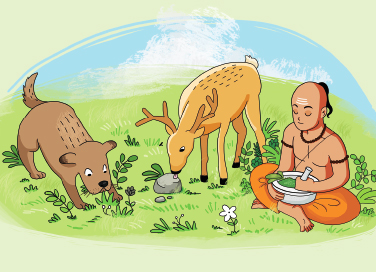Medicine In Ancient India and Ayurveda
- May 14, 2021


Medicine In Ancient India and Ayurveda
- May 14, 2021
By Harini Gopalswami Srinivasan
From prehistoric times, human beings have treated their diseases with natural herbs and minerals, in much the same way that a dog will nibble grass to cure an upset stomach, or a deer will lick salt to keep all its organs in working order.
The first documented knowledge about medicines in India is found in the Rig Veda (Oshadhi Sooktam) and the Atharva Veda, which are believed to be more than 5000 years old. In addition to providing mantras against diseases and information about useful plants and herbs, the Atharva Veda says that diseases are caused by organisms called yatudhana, kimidin, krimi, etc.
To receive more such stories in your Inbox & WhatsApp, Please share your Email and Mobile number.
Over the following centuries, the study of medicine grew more systematic, and became known as Ayur Veda (Life Science). Three important foundation texts of Ayurveda were compiled in the first millennium BCE: Atreya Samhita, Susruta Samhita, and Charaka Samhita. These texts cover all the branches of modern medicine, and describe over 600 drugs of animal, plant and mineral origin.
According to Ayurveda, an individual can enjoy good health only if the body, mind and soul are all properly nurtured. The human body, like the entire universe, is composed of five elements: Prithvi (earth), Apas (water), Tejas (energy/ fire), Vayu (air), and Akasa (empty space). When these are properly balanced, the body is said to be healthy. People are classified into three doshas or types — Vata, Pitta and Kapha. Vata has the qualities of air and space, and regulates all the movements of the body. Pitta has the qualities of fire and water, provides energy to the body and regulates our digestion, metabolism, temperature, sense organs and understanding. Kapha is composed of earth and water, and gives stability and structure to the skeleton and all the organs of the body. Depending on which of these elements are predominant in a person, cures are suggested.
To receive more such stories in your Inbox & WhatsApp, Please share your Email and Mobile number.

Comic of The Month
The Naval Journey of India Book I
This book is the first of a three-book series that takes a deep and detailed look at India's Naval History and a deep insight into the lives of our men and women in white. But any series on the Indian Navy has to start at the very beginning - exploring India's celebrated maritime history. Join our little hero, Bharat, and his grandfather, Commodore Sagar, as they sail into the deep blue waters of time. Book I of The Naval Journey of India takes a sweeping look at India's maritime endeavours, how the seas impacted us over millennia and how the oceans made us who we are.